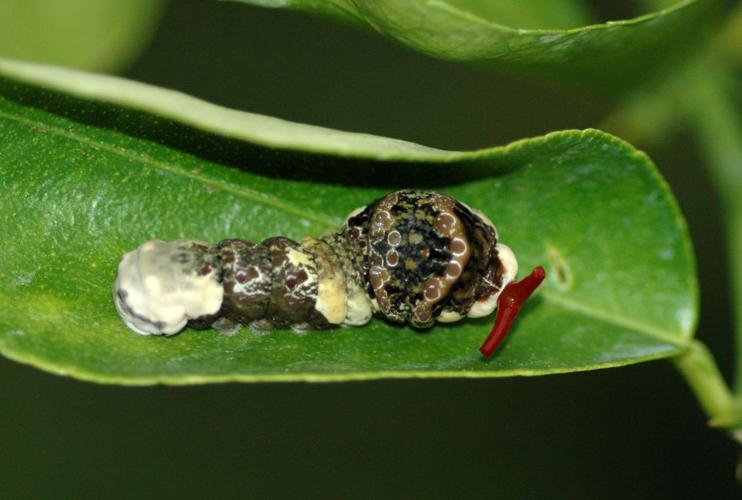Q: I found a very strange looking caterpillar crawling across my patio. I would like to know where it came from and if it is a problem.
A: The caterpillar you found is Sphingicampa hubbardi and is also known as Hubbard’s small silk moth or the mesquite moth. It is a Southwestern species in the Saturniidae family of silkworm moths found from extreme eastern California, southern Nevada, and southern Arizona into west Texas. They feed on honey mesquite and some species of acacia and related legumes. They are not common enough to be considered a pest. The adult moths have gray front wings covering bright red hind wings that they likely use to shock and awe predators while they make their escape.
Q: I have seen some people cutting the lower branches off their oleanders. Is this good for the plants?
A: In general, it is good to allow plants to achieve their natural form. Oleanders are tough enough to allow pruning them into informal hedges and small trees. Pruning should begin while they are young to train them into small trees and that is what I expect you are describing.
The down side to this is that oleanders require quite a bit of maintenance to remove suckers that will grow from the base as the plants try to regain their natural form. As a hedge, oleanders look best and are healthiest when they are allowed to grow to their natural shape. Selective pruning of branches back to a point of attachment on the main stem is a good way to prune them. It is not a good idea to shear oleanders into formal hedge shapes because they require a lot of maintenance to retain that shape and because shearing in general is stressful to any plant.
Q: I have some low weeds (spurge?) that are slowly taking over my tiff-green lawn. They are easy to kill in the gravel but what can I do about the lawn? Would something like Weed-B-Gone work and not kill the grass? What are your recommendations about fertilizing? Maybe a healthier lawn would crowd them out?
A: A healthier lawn would be the best thing to prevent spurge and other weeds from becoming established and that begins with good fertility for the grass. Ideal lawn fertilizers have a fertilizer ratio of 3:1:2 (examples: 15:5:10; 21:7:14) or 4:1:2 (example: 20:5:10).
Some lawn fertilizers may be classified as “slow release” because they release their nutrients slowly over weeks or months after an application. Quick release fertilizers are less desirable since they release nutrients in a very short period of time resulting in more frequent mowing.
Begin fertilizing after the grass turns green and there is little chance of a late frost, usually around April depending on your elevation. The last fertilizer application is usually no later than August if you are planning to overseed with a cool season grass.
The cool season grass used in overseeding dictates fertilizer applications during winter. If Bermuda grass is not to be overseeded, then late fall applications of nitrogen (October and November) can be used and may delay the onset of the winter brown color by a month or more if fall temperatures are mild.
Spurges are difficult to control, warm season, broadleaf weeds of landscapes, gardens and turf in the low deserts of Arizona. Fast growing and easily dispersed, spurges rapidly colonize and blanket areas where there is ample sunlight and moisture. Dicamba and 2,4-D are herbicides that control broadleaf plants only and can be used to selectively kill spurge in turfgrass without harming the grass.
These active ingredients are found a number of products including weed-b-gone. Be careful to stay away from other broadleaf plants such as trees and shrubs because the herbicide will kill them as well. It is probably best to spot treat to minimize the chance of damaging other nearby plants.
Beware that spurges sometimes harbor stinging ants. Some species of spurge have specialized structures called extrafloral nectaries, not for pollinators but that produce nectar as a food source for ants, which ants aggressively defend when the plant is disturbed. People with allergies or sensitivity to ant venom are at risk and should be careful around spurge.
Q: I am finding orange dog caterpillars on my citrus now. Some are very small and some are almost two inches long. Why are they different sizes? Wouldn’t they all hatch at the same time?
A: The giant swallowtail butterflies (Papilio cresphontes) that lay the eggs from which the orange dog caterpillars emerge are active throughout the citrus growing season so the caterpillars you are seeing are likely from more than one egg laying event and did hatch at different times.
These caterpillars, which famously look like bird poop, molt through five instars or phenophases before they form a chrysalis or pupa, from thence into beauty. The rate at which they grow is related to the availability of food and the air temperature. Since your caterpillars are all on the same plants with the same conditions, it is safe to say they are all growing at the same rate.
If you’re curious like me, you can monitor their growth as a science experiment to see how long it takes for them to pupate. If the idea of sharing your observations with others in the interest of science gives you a thrill (also like me), there is a program on the Internet and an app for your smartphone called Nature’s Notebook.
There is a workshop on how use this application at Brandi Fenton Memorial Park from 9 a.m. to noon Friday, Sept. 25. Register at the Pima County website, ow.ly/Sd21w.






